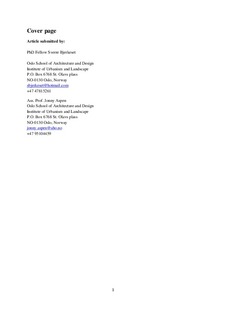| dc.contributor.author | Bjerkeset, Sverre | |
| dc.contributor.author | Aspen, Jonny | |
| dc.date.accessioned | 2018-04-04T08:37:30Z | |
| dc.date.available | 2018-04-04T08:37:30Z | |
| dc.date.created | 2016-12-12T13:32:49Z | |
| dc.date.issued | 2017 | |
| dc.identifier.citation | Journal of Urban Design. 2017, 22 (1), 116-132. | nb_NO |
| dc.identifier.issn | 1357-4809 | |
| dc.identifier.uri | http://hdl.handle.net/11250/2492514 | |
| dc.description.abstract | Based primarily on an observational study, this article addresses privately owned and managed public space at the Tjuvholmen waterfront development in Oslo. To date, no other research has been published internationally on external private-public space in a Nordic context. The four factors or processes dealt with are planning and development, design, management, and, in particular, use. The main finding is that Tjuvholmen’s public spaces are characterized by ‘tightness’ and reduced publicness. As such, they share key characteristics with private-public spaces described in the literature from the US and the UK, while they in some other respects also deviate from these. | nb_NO |
| dc.language.iso | eng | nb_NO |
| dc.title | Private-public space in a Nordic context: the Tjuvholmen waterfront development in Oslo | nb_NO |
| dc.type | Journal article | nb_NO |
| dc.type | Peer reviewed | nb_NO |
| dc.description.version | acceptedVersion | nb_NO |
| dc.source.pagenumber | 116-132 | nb_NO |
| dc.source.volume | 22 | nb_NO |
| dc.source.journal | Journal of Urban Design | nb_NO |
| dc.source.issue | 1 | nb_NO |
| dc.identifier.doi | 10.1080/13574809.2016.1240010 | |
| dc.identifier.cristin | 1411487 | |
| cristin.unitcode | 189,3,0,0 | |
| cristin.unitname | Institutt for urbanisme og landskap | |
| cristin.ispublished | true | |
| cristin.fulltext | postprint | |
| cristin.qualitycode | 1 | |
